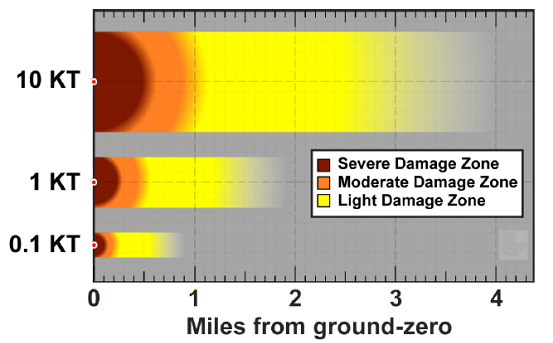Damage Zones after a Nuclear Detonation: Idealized Maps

- Representative damage zones for hypothetical 0.1, 1.0 and 10kT nuclear explosions.
- Circle areas are idealized for planning purposes and illustration, and are unlikely to be this symmetrical.
- Borders between zones are likely to be less distinct.
Source: Planning Guidance for Response to a Nuclear Detonation, Second edition, 6/2010 (PDF - 2.62 MB) (National Security Staff, Interagency Policy Coordination Subcommittee for Preparedness & Response to Radiological and Nuclear Threats, Figure 1.2)

Zone distances for 0.1, 1, and 10 KT explosions are shown for zone size comparison.
Source: Planning Guidance for Response to a Nuclear Detonation, Second edition, 6/2010 (PDF - 2.62 MB) (National Security Staff, Interagency Policy Coordination Subcommittee for Preparedness & Response to Radiological and Nuclear Threats, Figure 1.3)
-
Light Damage (LD) Zone:
- Damage is caused by shocks, similar to those produced by a thunderclap or a sonic boom, but with much more force. Although some windows may be broken over 10 miles (16 km) away, the injury associated with flying glass will generally occur at overpressures above 0.5 psi. This damage may correspond to a distance of about 3 miles (4.8 km) from ground zero for a 10 KT nuclear explosion. The damage in this area will be highly variable as shock waves rebound multiple times off of buildings, the terrain, and even the atmosphere.
- As a responder moves inward, windows and doors will be blown in and gutters, window shutters, roofs, and lightly constructed buildings will have increasing damage. Litter and rubble will increase moving towards ground zero and there will be increasing numbers of stalled and crashed automobiles that will make emergency vehicle passage difficult.
- Blast overpressures that characterize the LD zone are calculated to be about 0.5 psi at the outer boundary and 2-3 psi at the inner boundary. More significant structural damage to buildings will indicate entry into the moderate damage zone.
-
Moderate Damage (MD) Zone:
- Responders may expect they are transitioning into the MD zone when building damage becomes substantial. This damage may correspond to a distance of about one mile (1.6 km) from ground zero for a 10 KT nuclear explosion. The determination is made by ground-level and/or overhead imagery.
- Observations in the MD zone include significant structural damage, blown out building interiors, blown down utility lines, overturned automobiles, caved roofs, some collapsed buildings, and fires. Some telephone poles and street light poles will be blown over. In the MD zone, sturdier buildings (e.g., reinforced concrete) will remain standing, lighter commercial and multi-unit residential buildings may be fallen or structurally unstable, and many wood frame houses will be destroyed.
- Substantial rubble and crashed and overturned vehicles in streets are expected, making evacuation and passage of rescue vehicles difficult or impossible without street clearing. Moving towards ground zero in the MD zone, rubble will completely block streets and require heavy equipment to clear.
- Within the MD zone, broken water, gas, electrical, and communication lines are expected and fires will be encountered.
- Many casualties in the MD zone will survive, and these survivors, in comparison to survivors in other zones, will benefit most from urgent medical care.
- A number of hazards should be expected in the MD zone, including elevated radiation levels, potentially live downed power lines, ruptured gas lines, unstable structures, sharp metal objects and broken glass, ruptured vehicle fuel tanks, and other hazards.
- Visibility in much of the MD zone may be limited for an hour or more after the explosion because of dust raised by the shock wave and from collapsed buildings. Smoke from fires will also obscure visibility.
- Blast overpressures that characterize the MD zone are an outer boundary of about 2-3 psi and inner boundary of about 5-8 psi. When most buildings are severely damaged or collapsed, responders have encountered the severe damage zone.
-
Severe Damage (SD) Zone:
- Few, if any, buildings are expected to be structurally sound or even standing in the SD zone, and very few people would survive; however, some people protected within stable structures (e.g., subterranean parking garages or subway tunnels) at the time of the explosion may survive the initial blast.
- Very high radiation levels from prompt and residual origin and other hazards are expected in the SD zone, significantly increasing risks to survivors and responders. Responders should enter this zone with great caution, only to rescue known survivors.
- Rubble in streets is estimated to be impassable in the SD zone making timely response impracticable. Approaching ground zero, all buildings will be rubble and rubble may be 30 feet deep or more.
- The SD zone may have a radius on the order of a 0.5 mile (0.8 km) for a 10 KT detonation. Blast overpressure that characterizes the SD zone is 5-8 psi and greater.
See also:
- Damage Zones after a Nuclear Detonation & "Zoned Approach" to the Response
- Damage Zones, Radiation Zones and Likely Rescue Activities after a Nuclear Detonation: Table
- Radiation Triage, Treat, and Transport System (RTR) after a Nuclear Detonation: Venues for the Medical Response
- Time Sequenced Size of Dangerous Fallout Zone and 0.01 R/Hour Boundary after a Nuclear Detonation

